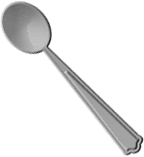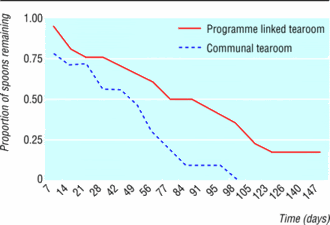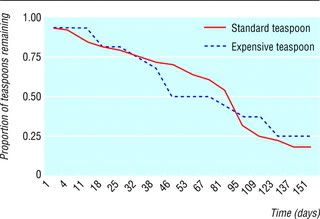 (Subtitle: There is no spoon...)
(Subtitle: There is no spoon...)
Oh, those crazy Aussies. What will they think of next?
Objectives To determine the overall rate of loss of workplace teaspoons and whether attrition and displacement are correlated with the relative value of the teaspoons or type of tearoom.
Design Longitudinal cohort study.
Setting Research institute employing about 140 people.
Subjects 70 discreetly numbered teaspoons placed in tearooms around the institute and observed weekly over five months.
Main outcome measures Incidence of teaspoon loss per 100 teaspoon years and teaspoon half life.
Results 56 (80%) of the 70 teaspoons disappeared during the study. The half life of the teaspoons was 81 days. The half life of teaspoons in communal tearooms (42 days) was significantly shorter than for those in rooms associated with particular research groups (77 days). The rate of loss was not influenced by the teaspoons' value. The incidence of teaspoon loss over the period of observation was 360.62 per 100 teaspoon years. At this rate, an estimated 250 teaspoons would need to be purchased annually to maintain a practical institute-wide population of 70 teaspoons.
Conclusions The loss of workplace teaspoons was rapid, showing that their availability, and hence office culture in general, is constantly threatened.
And of course, they even have their data graphed:

Table 1: Proportion of teaspoons remaining by final tearoom type

Table 2: Proportion of teaspoons remaining by teaspoon type
Their conclusions? Though they initially propose a "tragedy of the commons" type explantion, they prefer another avenue of thought:
We propose a somewhat more speculative theory (with apologies to Douglas Adams and Veet Voojagig). Somewhere in the cosmos, along with all the planets inhabited by humanoids, reptiloids, walking treeoids, and superintelligent shades of the colour blue, a planet is entirely given over to spoon life-forms. Unattended spoons make their way to this planet, slipping away through space to a world where they enjoy a uniquely spoonoid lifestyle, responding to highly spoon oriented stimuli, and generally leading the spoon equivalent of the good life.
Our data might also be contemplated through the prism of counterphenomenological resistentialism, which holds that les choses sont contre nous (things are against us). Resistentialism is the belief that inanimate objects have a natural antipathy towards humans, and therefore it is not people who control things but things that increasingly control people. Although it seems unreasonable to say that the teaspoons are exerting any influence over the Burnet Institute's employees (with the exception of the authors), their demonstrated ability to migrate and disappear shows that we have little or no control over them.
(This explanation again, of course, reminds me of "intelligent design" and its claims...)
Though this is obviously a humorous publication, it's actually one that can be used to get across the ideas of study design and data analysis to students, without having to deal with any understanding of complicated biology.
epidemiology, um, Silverware

Were inexpensive spoons plastic and expensive metal?
I'd love to see the study replicated with sporks. And knives. And coffee-mugs. And pens, oh yeah, definitely pens and Sharpie markers!
Oh, I see you started a new category - Silverware. I am looking forward to future posts in this category. Is this going to be a Wednesday regular event?
I agree with coturnix about the pens. Back in college, one of my lecturers used an analogy with pens in an office to clarify Fick's Law (diffusion), pointing out the fact that there is a non-zero probability that a pen will diffuse to an office on the other side of the world. He didn't get very quantitative about it, so it would be great to see this important phenomenon studied more thoroughly!
I would like to see a followup study showing spatial distribution at the beginning and end of the study period. Maybe some sort of RFID could be used, although that would presumably increase the value of the spoons.
Someone's gunning for an Ignoble award early in the year, it seems. :p
They don't mention any plastic spoons; I'd assume they were all metal, but "cheap" metal vs. a sturdier, more expensive design for the results in table 2. Re: silverware blogging, I can't promise anything. :) We'll have to see what kind of follow-up studies they'll provide...in the comments to the article, there were all sorts of humorous suggestions.
free solitaire Keyword doesn't matter